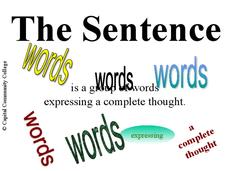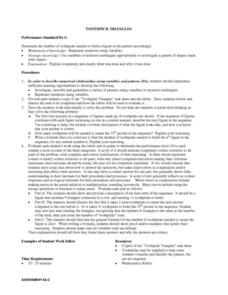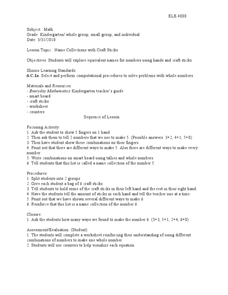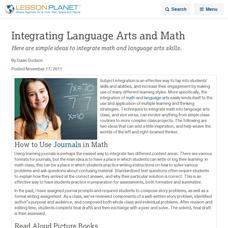Curated OER
Subject and Predicate
The subject and the predicate are two vocabulary words that every young writer must know. This short, but effective, presentation aptly describes what the subject and predicate are, what role they play in a sentence, and offers some...
Thoughtful Education Press
Compare and Contrast
Encourage readers to compare and contrast the information that they find in informational text with a variety of reading passages and worksheets. Learners read all about subjects in science, social studies, and literature...
Curated OER
Rooster's Off to See the World
Young learners listen to the book Rooster's Off to See the World, and complete simple math activities using the book. In this simple math lesson, students read and list the animals in the book. They arrange animal picture squares using...
Scholastic
Extension Activity Building a Healthy Classroom Community
Workout buddies aren't just for adults! Learners discuss the benefits of 60 minutes of physical activity each day and generate ideas for how they can accomplish this by working toward a goal with friends.
Statistics Education Web
The United States of Obesity
Mississippi has both the highest obesity and poverty rate in the US. Does the rest of the data show a correlation between the poverty and obesity rate in a state? Learners tackle this question as they practice their skills of regression....
Pennsylvania Department of Education
Using Polygons to Represent Fractions
Explore the world of fractions by using pattern blocks to show how different shapes can divide a hexagon. Elementary schoolers work in groups to complete these problems and to answer questions. Later, they work complete an independent...
Curated OER
It Just Keeps Going and Going...
Students explore patterns, identify patterns, and complete a variety of patterns. They view and discuss an online video and identify the different patterns from the film, then using a hundreds grid create an original pattern using their...
Curated OER
Toothpick Triangles
Students draw a chart (included in the lesson) to use with their investigation. They review terminology of triangles and receive toothpicks to use in the lesson. Beginning with three toothpicks, students form a triangle. They complete...
Shodor Education Foundation
Sets and the Venn Diagram (Beginner)
Venn diagrams are helpful in understanding the idea of a set and using attributes to sort items. This basic plan is an introduction with an added bonus of an applet that can be used to demonstrate the activity. If a classroom of...
Curated OER
Yummy Gummy Subtraction
Here is a quick 15 minute lesson intended to introduce subtraction. Learners count and subtract gummy bears to complete 5 problems. The lessons suggest that the gummy bears can be saved and used the next day, but gummy bears get gross...
Curated OER
Name Collections with Craft Sticks
Groups of Kindergarten students count craft sticks in different groups and name how many they have. They complete simple addition to ten with the use of manipulatives.
Curated OER
Graphing Greenery
Students gather leaves and trace them on graph paper. They plot coordinates that approximate the shape of the leaves and share those coordinates as "worksheets" for other students to complete.
Curated OER
Rolling with Links
First graders explore geometry by completing a worksheet in class. In this non-standard measurement unit lesson, 1st graders discuss different techniques for measuring items without the use of a ruler. Students read several short stories...
Curated OER
Ladybug Math
Students count the number of spots on ladybug wings. They add to find total number of spots on ladybug cut outs and complete the associated worksheet. They write ladybug addition story problems.
Curated OER
Kid Pix Math
Second graders, using Kid Pix, write and illustrate simple addition and subtraction sentences using Kid Pix. After each student has completed his/her work, it is printed out and bound into a class book.
Curated OER
What is the Average Height of Your Class?
For this statistics lesson, learners use an on-line form generator create a class-specific form, then complete the form, view a graph and data analysis, and draw conclusions.
Curated OER
Critical Thinking Strategies
Teach your readers to be critical thinkers. A strategy is outlined that can be used to compare and contrast entities. An example lists four states. The learner removes one state that "does not belong" in the list for some reason, and...
Curated OER
Problem Solving with the Wilderness Classroom
Students complete 45 multiple choice math word problems. In this math word problems lesson plan, students solve word problems on time, graphing, all four operations, money, and more.
Curated OER
Multiplication Rule: Complements and Conditional Probability
For this probability worksheet, students read story problems and set up complement and conditional probability problems according to the multiplication rule. Three story problems are included on this worksheet.
24x7 Digital
TeachMe: 1st Grade
Let your eager learners practice their basic arithmetic and spelling skills with this fun interactive resource! For any primary grade teacher with access to an Apple mobile device, this is a must-have application.
Curated OER
Beginning Multiplication Worksheet - Part One
Students practice multiplication skills. In this multiplication lesson plan, students complete beginning multiplication problems. Students multiply the given numbers by ones and twos. Students complete 25 problems.
Curated OER
One Good Turn Deserves Another
Students make observations about shapes and 1-, 2-, and 3-dimensional objects. They conduct observations and make predictions regarding transformations of simple geometric shapes. They identify shapes that occur in household items.
Curated OER
Integrating Language Arts and Math
Here are simple ideas to integrate math and language arts skills.
Curated OER
Math Journal: Functions and Coordinate Geometry
Fifth graders examine the many uses of coordinate grids. In this graphing lesson, 5th graders write data driven equations, discuss the x and y-axis, and determine if using 2 or 3 ordered pairs is better. Students complete several...























